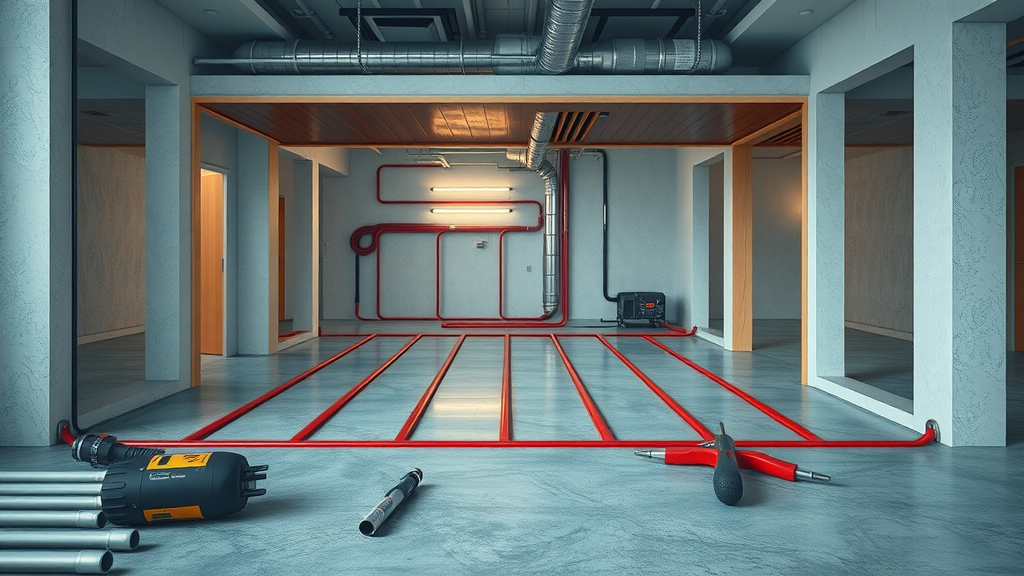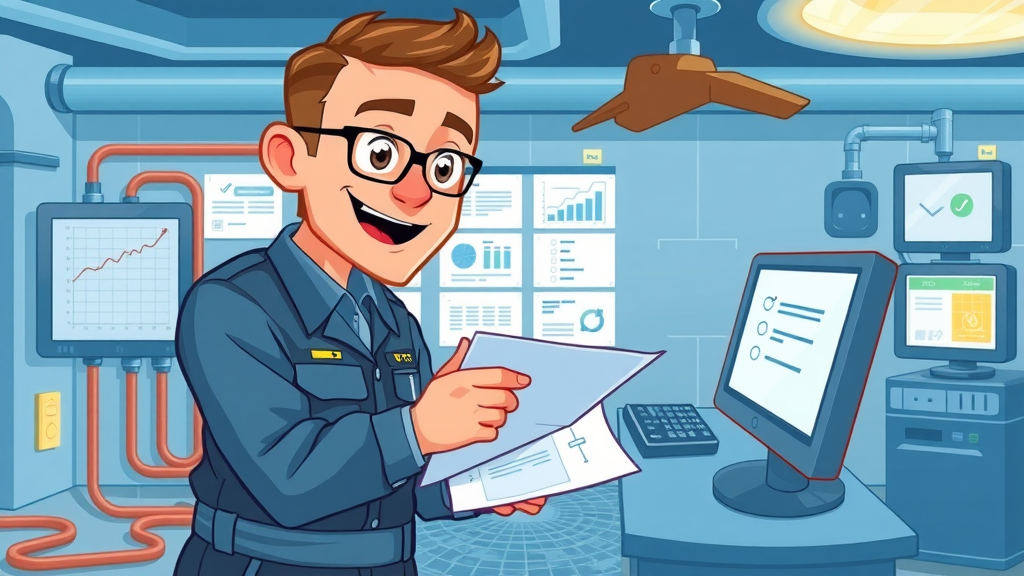Did you know? A single neglected underfloor heating system can increase energy bills by as much as 25% in a single year, costing businesses thousands in avoidable expenses. For forward-thinking commercial property owners, smart underfloor heating maintenance doesn’t just keep the floor warm—it guards your budget against spiralling costs and unexpected breakdowns.
A Surprising Fact: Why Underfloor Heating Maintenance Can Save Your Business Thousands
Commercial buildings now often choose underfloor heating for comfort, energy efficiency, and that sleek, unobtrusive finish. But here’s what most owners don’t realise: without regular heating maintenance, small issues—like trapped air or minor leaks—grow into big, costly repairs. Systems left unchecked contribute to uneven heating, higher utility bills, and even invalidate warranties. That’s why underfloor heating maintenance isn’t optional; it’s a core strategy for controlling your operational costs and keeping tenants or employees comfortable year-round.
Consider this: a typical office with well-maintained wet underfloor heating spends up to 40% less on heating-related repairs and enjoys a system lifespan exceeding 25 years. In contrast, poor maintenance can halve that life, making you pay double for avoidable faults. Proactive inspection, bleeding, flushing, and professional oversight easily pay for themselves by preventing expensive emergencies and protecting property value. That’s the power of getting ahead with smart maintenance for your floor heating assets.

What You’ll Learn: Maximising Savings and System Lifespan with Underfloor Heating Maintenance
The essential steps of effective underfloor heating maintenance
How to spot early warning signs of costly floor heating failures
Real-world results: before-and-after cost comparisons
Expert guidance on maintenance schedules for underfloor heating systems
Comparison of servicing needs: wet underfloor heating and electric systems
Understanding Underfloor Heating Maintenance for Modern Commercial Environments
What Is Underfloor Heating Maintenance?
Underfloor heating maintenance is a series of regular checks, tasks, and professional inspections designed to keep your building’s floor heating system running smoothly year after year. For commercial spaces, maintaining underfloor heating is vital—not only to deliver even heat for comfort but also to avoid the operational headaches caused by cold spots or system breakdowns. Maintenance tasks typically include visual and thermal imaging inspections, checking sensors and controls, flushing or bleeding (for wet systems), and testing electric underfloor heating circuits. The goal is to keep the system energy-efficient, extend its useful life, and safeguard your investment.
Ignoring heating maintenance can allow minor issues like trapped air in pipes or unnoticed electrical faults to escalate, often leading to business disruption or expensive emergency repairs. Regular underfloor heating maintenance helps you spot these early, ensuring your underfloor heating system delivers maximum performance for as long as possible. For commercial property owners, this means predictable costs, happier tenants or customers, and a system that works flawlessly through the toughest months. Ultimately, if you want the benefits of energy-saving floor heating, you need a tailored maintenance plan in place.
For those looking to take a more hands-on approach, there are several practical steps you can implement to keep your system in top condition. Discover actionable underfloor heating maintenance tips to avoid costly repairs and ensure your investment continues to deliver reliable comfort and efficiency.
Key Differences: Wet Underfloor Heating vs Electric Underfloor Heating Systems
Both wet underfloor heating systems, which use warm water flowing through pipes beneath the floor, and electric underfloor heating, which uses electric cables or mats, offer efficient heat distribution. However, when it comes to underfloor heating maintenance, their requirements are quite different. Wet systems often demand more attention, such as annual bleeding the system to remove trapped air and periodic flushing to clear out debris that can cause blockages. These maintenance steps are essential to maintain consistent flow and heat in water-based systems, preventing uneven heating and avoiding leaks.
Electric underfloor heating, meanwhile, generally needs fewer maintenance interventions but requires routine sensor checks, control recalibration, and periodic testing to pick up electrical faults or insulation wear. Neglecting electric systems can still lead to cold spots and system failures, although issues often manifest as malfunctions in specific zones rather than water leaks. Scheduled checks are key to prolonging the life of electric floor heating and ensuring safe, continuous operation—especially in larger commercial installations where downtime can instantly impact your business.
Comparing Floor Heating: Wet Underfloor Heating System vs Electric Underfloor Heating System – Maintenance Tasks, Costs, and Typical Intervals |
|||
System Type |
Typical Maintenance Tasks |
Frequency |
Estimated Cost (per visit) |
|---|---|---|---|
Wet Underfloor Heating |
Bleeding, Flushing, Leak Inspection, Flow Balancing, Thermostat & Sensor Check |
Bleeding: Yearly |
£150–£400 |
Electric Underfloor Heating |
Electrical Circuit Testing, Sensor Calibration, Insulation Resistance Check |
Inspection: Every 1–2 years |
£100–£250 |

The Importance of Regular Heating Maintenance for Business Properties
Cost Implications: Ignoring Underfloor Heating Systems
Neglecting heating maintenance for your underfloor heating system poses real risks for your business’s bottom line. Seemingly minor problems like airlocks or sediment buildup can escalate rapidly, resulting in uneven heating, inefficient energy use, and expensive emergency repairs. If left unchecked, a leaking wet underfloor system could require full or partial floor excavation, costing businesses thousands and disrupting operations. Data shows that facilities failing to keep up with regular underfloor heating maintenance spend, on average, 30–40% more on annual repair bills than their proactive counterparts. Plus, invalid warranties due to poor maintenance can shift even more replacement costs onto the owner.
It’s not just about avoiding emergencies: when your floor heating isn’t maintained, you’ll notice climbing energy bills, as the system uses more power to deliver the same warmth. This impacts your business’s profit margins and carbon footprint. Proactive underfloor heating maintenance is a low-cost insurance policy that protects your investment, ensures even heat distribution, and delivers a reliable, comfortable environment for staff and clients alike.
Enhancing Energy Efficiency with Scheduled Heating System Checks
Maintaining your underfloor heating system with planned inspections and servicing isn’t just a “nice-to-have”—it’s a proven route to serious energy savings. Routine maintenance, such as thermal imaging inspections to detect cold spots, or recalibrating controls, ensures each zone of your system is running efficiently and using the minimum possible energy. Identifying and fixing small inefficiencies (like a partially blocked water circuit or a faulty electric sensor) helps preserve the system's designed performance and can cut heating costs by up to 15–25%.
For commercial property managers, this means more predictable utility bills, improved sustainability metrics, and reduced risk of occupant complaints about comfort. By ensuring your system runs optimally, scheduled underfloor heating checks pay for themselves year after year. And when you boost your building’s energy efficiency, it doesn’t just make financial sense—it's also vital for meeting modern environmental standards and enhancing the marketability of your property.
Compliance and Warranty: What Commercial Owners Must Know about Floor Heating Maintenance
When you invest in floor heating, you’re also making a commitment to maintenance—often a requirement directly outlined by the manufacturer to keep your system warranty valid. Many warranties become void if essential servicing tasks (such as bleeding a wet underfloor system, or annual electrical inspections) aren’t documented. For commercial owners, adhering to these requirements protects you from expensive, out-of-pocket repairs and keeps your insurance policies in good standing. Beyond compliance, regular heating maintenance provides an audit trail, demonstrating due diligence when seeking to claim for any system fault or major failure.
Staying on top of scheduled maintenance also aligns with legal obligations related to building services safety, especially in commercial settings. Regular reporting, system performance audits, and fully qualified heating engineers give peace of mind—ensuring you’re both protected legally and offering the best possible service to your occupants. Ignoring these responsibilities is a false economy, risking both company finances and reputation.
"Proper underfloor heating maintenance can extend system life by up to 40%, reducing both operating and capital replacement costs." – Industry Expert

Step-by-Step Guide: Smart Underfloor Heating Maintenance Process
Initial Assessment of Heating System Performance: Begin with a comprehensive review of sensors, controls, and occupant feedback for any early warning signs like uneven heating or excessive utility usage. Document any observed potential issues so you target maintenance where it's needed most.
Bleeding Wet Underfloor Heating to Remove Airlocks: Yearly air removal avoids trapped air pockets that cause cold spots. This vital task helps keep your system running efficiently and water flowing evenly throughout your building.
Visual and Thermal Imaging Inspections of Floor Heating: Use state-of-the-art tools to identify invisible problems, such as hidden leaks, cold spots, or failing electrical zones—providing a full health snapshot for both wet and electric systems.
Checking for Leaks and Faults in Wet Underfloor Heating Systems: Inspect all joints and manifolds for seepage, and pressure test circuits to catch leaks before they damage floor coverings or substructures.
Testing Electric Underfloor Heating Functions: Qualified technicians test circuit continuity, verify sensor readings, and ensure controls are calibrated for safe, consistent heat distribution.
Flushing Underfloor Heating System for Maximum Efficiency: Every 5–7 years, a full system flush clears out built-up debris and sediment, restoring original performance and reducing boiler strain in wet systems.
Reviewing Heating Controls and Sensors: Update and calibrate thermostats, occupancy sensors, and zoning controls for precision temperature management and energy savings.
Scheduling Professional Service Intervals: Work with underfloor heating experts to set annual or bi-annual maintenance, ensuring compliance with manufacturers’ and insurers’ standards.

People Also Ask: Underfloor Heating Maintenance Questions Answered
Does underfloor heating require maintenance?
Yes, all underfloor heating systems need regular maintenance to ensure optimal performance, prevent breakdowns, and protect manufacturer warranties. Neglecting underfloor heating maintenance can lead to efficiency losses and costly repairs.
How often do you need to bleed underfloor heating?
For wet underfloor heating systems, bleeding should typically be done annually or if there are signs of trapped air, such as uneven heating or gurgling sounds.
What is the life expectancy of underfloor heating?
With effective underfloor heating maintenance, modern systems can last over 25 years. Poor maintenance may reduce their lifespan dramatically.
Does underfloor heating need to be flushed?
Yes, flushing a wet underfloor heating system clears out sediment and blockages, ensuring maximum flow and efficiency. This is generally advised every 5–7 years.
Demonstration: Professional Inspection and Maintenance Steps for Commercial Underfloor Heating Systems
Common Issues Solved by Underfloor Heating Maintenance
Uneven floor temperatures
Noisy heating pipes
Slow system warm up
Leaks in wet underfloor heating systems
Electric underfloor heating sensor malfunctions

How to Set Up a Bespoke Heating Maintenance Plan for Your Property
Checklist: What to Include in a Commercial Floor Heating Maintenance Agreement
Regular technical inspections
System performance audits
Annual bleeding (wet underfloor heating)
Flushing schedules
Sensor and thermostat testing
Comprehensive reporting
FAQs on Underfloor Heating Maintenance
How does underfloor heating maintenance differ from standard heating systems?
Underfloor heating maintenance focuses on specialised tasks like bleeding, flushing, and sensor calibration—tasks often not required with conventional radiators or forced-air systems. Floor heating systems operate discretely below surfaces, so regular thermal imaging and moisture detection are more critical than for traditional setups. Unlike standard systems, hidden leaks or electrical faults in underfloor heating can go undetected for longer, so a proactive approach is essential to ensure even heat and protect your property investment.
Can regular floor heating maintenance boost my building's energy rating?
Absolutely. Consistent heating maintenance keeps systems working at peak efficiency, minimising energy waste and ensuring quick, even warm-up times. This can directly influence your building’s EPC (Energy Performance Certificate) score, making your property more attractive to tenants and investors committed to sustainability. Energy ratings are increasingly important for commercial leasing, so maintaining your underfloor heating is a smart way to enhance value.
Is heating maintenance disruptive to business operations?
Well-planned underfloor heating maintenance is designed to fit around your schedule and minimise business interruption. Most inspection and servicing tasks are non-invasive and can be completed outside of normal operating hours if required. Modern diagnostic tools make the process faster and more precise, so your staff experience maximum comfort and minimum inconvenience—all while protecting your company’s assets.
Key Takeaways: Protect Your Investment with Smart Underfloor Heating Maintenance
Early maintenance prevents major repairs and keeps costs predictable
Professional inspections maximise floor heating energy savings
Tailored plans help commercial properties meet legal and insurance requirements
Peak Underfloor Heating Ltd experts ensure comprehensive care for any underfloor heating system

Conclusion: The Value of Proactive Underfloor Heating Maintenance
Your commercial property’s true value comes from systems that are efficient, reliable, and problem-free. Choose regular underfloor heating maintenance to save costs, boost comfort, and protect your investment year after year.
Why Engage Peak Underfloor Heating Ltd for Your Next Project
Choose Peak Underfloor Heating Ltd for industry-leading expertise, fully qualified engineers, and tailored maintenance plans that keep your business running smoothly. Let us help you enjoy energy savings, system reliability, and peace of mind. Contact us for expert advice and a bespoke maintenance plan for your property.
Ready to Get Started? Contact Us Now
It can be difficult to know exactly what system is best for your application so if you are still unsure please feel free to contact us and one of our consultant’s will be happy to discuss your exact requirement’s. Call 01246 387120, or Email us at info@peakunderfloorheating.com
If you’re considering a broader upgrade to your property’s heating, it’s worth exploring how underfloor heating compares to other solutions in terms of efficiency, comfort, and long-term value. For a comprehensive look at the pros and cons of different systems, including how underfloor heating stacks up against traditional radiators, take a look at our in-depth guide on underfloor heating versus radiators. This resource will help you make informed decisions for your next project, ensuring you choose the best fit for your business needs and future-proof your investment. Delve deeper to unlock advanced insights and strategies for optimising your building’s comfort and operational efficiency.
Sources
Regular maintenance of your underfloor heating system is essential to ensure its efficiency and longevity. For comprehensive guidance, consider the article Top Underfloor Heating Maintenance Tips for Long-Term Efficiency, which offers practical advice on tasks like bleeding the system to remove air pockets and keeping components clean to prevent energy wastage. Additionally, Underfloor Heating Maintenance and Servicing provides insights into routine checks, such as monitoring system pressure and ensuring thermostats are correctly programmed, to maintain optimal performance. By following these expert recommendations, you can prevent costly repairs and enjoy a comfortable, energy-efficient environment year-round.
 Add Row
Add Row  Add
Add 









Write A Comment